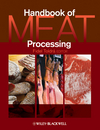Processing
Consistency is key, big batch or small
Mixer technology continues to help processors reduce blend and discharge times without sacrificing product quality or consistency.




Small batch versus large batch mixing: which one works better? It all depends on how the operating controls are set.
“Larger mixers may have better agitator or axle arrangements and temperature controls that can more efficiently mix product compared to a smaller batch mixer,” says Wes Osburn, Ph.D., associate professor of meat science, Texas A&M University. “However, setting operating controls for raw materials, mixing times and product temperatures will ensure that a consistent product is blended regardless of the style or type of mixer available.”
Ground fresh and cooked sausages couldn’t be made without the blending or mixing process. In short, during this critical step in the manufacturing process, raw materials are added to the mixer and blended to achieve the desired fat content and uniform distribution of any added non-meat ingredients.
“Depending upon the type of product to be manufactured, the mixing step applies mechanical action to the meat to maintain particle definition — for fresh sausages — and/or extract protein for binding — with cooked sausages,” says Osburn.
The mixers employed can have small capacities (for less than 100 pounds of materials) to very large capacities (greater than 1,000 pounds).
“Most mixers have polished interiors, with newer models having ‘electropolished’ interiors with smooth welds to reduce product adhesion to the mixer side walls and agitators [or axles],” says Osburn. “This ensures that the entire product is effectively evacuated from the blender and enhances cleaning of the mixer.”
Small batch vs. large batch
Whether a small batch is being mixed or a large batch, the same mechanical action is applied to uniformly distribute the meat or meats and any other added ingredients, he notes.
The product temperature will change during the mixing process, whether it is in a small or large batch, but this variance can be controlled by adding cold water, ice or by employing an injection chilling system.
And protein extraction, another key step in the mixing process, is enhanced by the addition of salt, phosphate and water, regardless of batch size.
“The key to either small or large batch mixing is to ensure that the equipment is operated properly and consistently — batch after batch,” says Osburn.
Indeed, the raw materials used for mixing, for example, should be standardized for grind size, temperature and fat content.
Then, the mixer should only be filled to at least 60 percent to 70 percent of its capacity, so it’s not overloaded.
Also the ingredients used should be uniformly incorporated into the mixer during the initial stages of mixing.
“Proper mixing times should be set and followed to achieve acceptable protein extraction and fat distribution for desired product bind and texture,” says Osburn. “Under-mixing or over-mixing can result in undesirable final product texture.”
Standardizing food safety
The meat industry’s continued focus on food safety has resulted in improved mixing equipment design with sanitary features such as quick-release shaft seals, solid mixing shafts and easy access and disassembly for cleaning.
“Other key features include options for mixer agitators — standard paddle, ribbon or other hybrids [for example, overlapping or counter-rotating paddles] — that can be customized by the manufacturer to meet customer specifications,” says Osburn.
Depending upon the process or product requirements, processors can use other recent mixer features to improve the blending process. Vacuums, for one, are being added to mixers now, because air removal increases protein extraction, absorption of ingredients and creates a denser product, says Osburn. Liquid carbon dioxide or liquid nitrogen injection are being utilized to aid the chilling process. And steam injection features assist with the mixer’s cooking capabilities.
“Mixer technology continues to focus on innovative technology to help processors reduce blend and discharge times without sacrificing product quality or consistency,” says Osburn. “Advanced mixers possess a scale to weigh the meat blend and individual ingredients to standardize the product formulation, improve consistency and reduce processing times.”
Improved digital controls allow the selection of the desired agitator speed during mixing and discharging, such as low or high speed or variable speed controls. They also can select directions such as forward, for mixing, and reverse, for discharge.
“Additionally, mixer program controls can adjust mixing times, application of liquid carbon dioxide or nitrogen chilling and steam injection and vacuum pressure,” says Osburn.
Looking for a reprint of this article?
From high-res PDFs to custom plaques, order your copy today!











